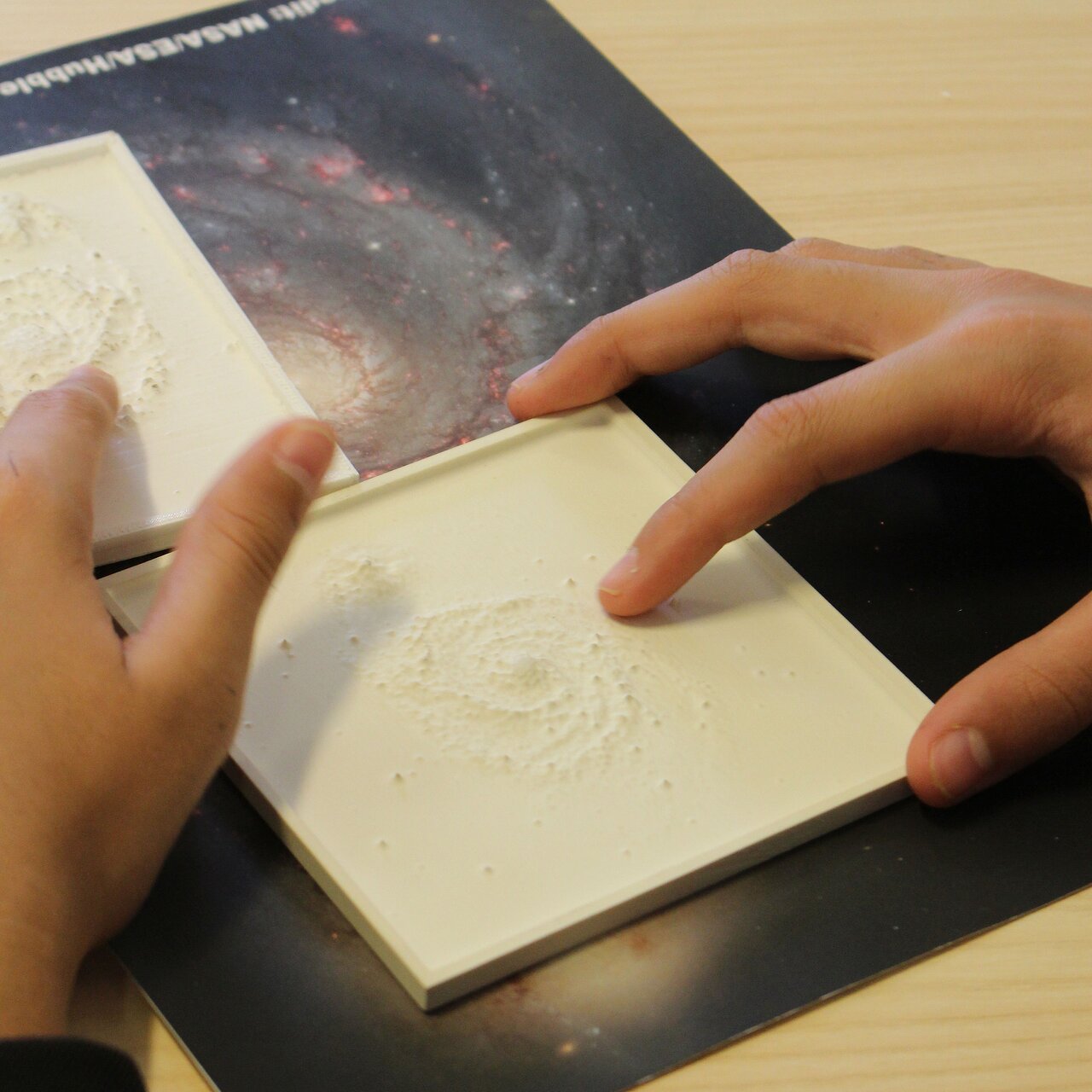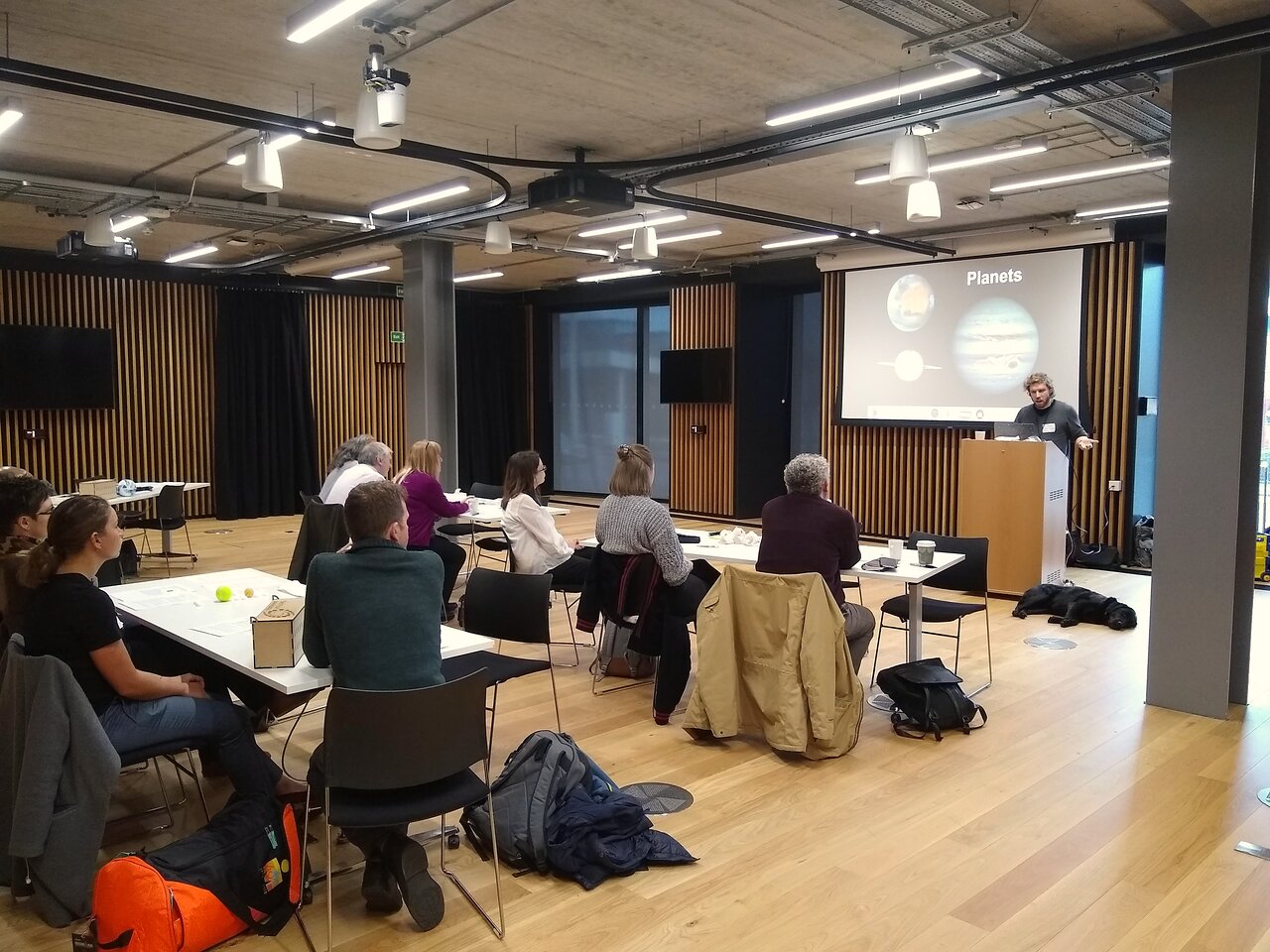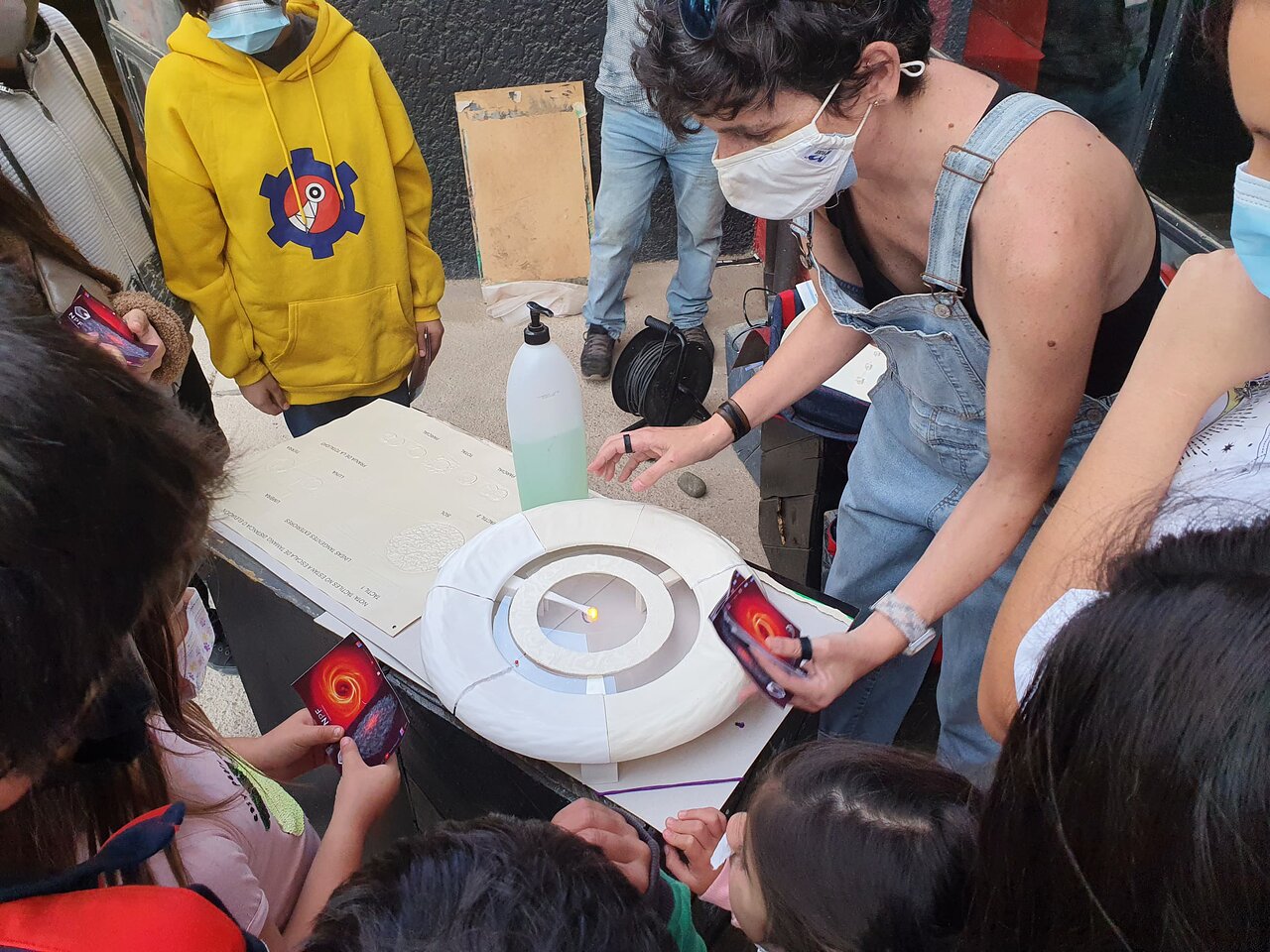- How some groups are making astronomy more accessible, using resources you can touch
- Why these more inclusive tools benefit everyone
A recording of this article, read by Amy Briggs (ESO Communication Intern), is available here:
https://eso.org/public/archives/static/blog/accessible-astronomy/2025-05-21_Accessibility-in-Astronomy-Part01.mp3
All scientists have to interpret their data, engaging their senses to understand, communicate and explain their work. Astronomers often create stunning images, artistic impressions, and — for the hardcore enthusiasts — graphs. But these visualisations are a barrier for people with impaired vision, leaving an entire community on the sidelines when it comes to interpreting the Universe. However, in the last decade, teams of researchers and communicators around the world have been showing us that this barrier doesn’t need to exist.
Reach out, touch space
The Tactile Universe is a scheme based in Portsmouth, UK, led by Nicolas Bonne, a vision-impaired astronomer with a background in galaxy evolution and a determination to improve access to astronomy. His team creates 3D-printed handheld models for astronomical outreach.
Nic was only 5 when he realised he wanted to be an astronomer. Inspiration hit him through what he was able to discern, using his limited vision, in the images captured by the Voyager missions of the 80s. “I remember watching a documentary [about them] narrated by Carl Sagan… Trying to see those pictures, but then having [his] descriptions helping me understand what I was seeing — that, for my 5-year-old brain, was just the most amazing thing ever,” he says. The experience changed the direction of the rest of his life. ”I just kinda went ‘wow, space is great, I wanna do space’.”
Despite being a dedicated and hard-working student, the visual nature of astronomy meant that ‘doing space’ wasn’t always easy. Nic considers himself lucky that he found passionate educators who helped him to find ways of doing things that worked, but accessing the resources he needed sometimes proved difficult.
As he continued through higher education, the difficulties of observational astronomy and the constant need for support became overwhelming. “I actually quit [my] first PhD,” he says, at the time thinking “yeah, I'm never going to be an astronomer”. However, his passion soon drew him back to finish his PhD with the support of a few key academics.
When asked about what might have made his work easier as a student, Nic looked back on his experiences and suggested “we [the university] could have made the images tactile. If I could have felt them instead of trying to look at them… [that] would have made my life so much easier.”
And so, the idea for the Tactile Universe was born.

Catching starlight
Nic’s physical models take pictures of space, and map the brightness of light in the image into relative heights of grooves and bumps in plastic. By feeling the raised — and therefore brighter — spots, anyone can touch the light of a star, or sense the shape of galaxies.
He describes the first time feeling one of these 3D-printed models as “a transformative experience… it was exactly what I’d imagined”. By exploring the galaxy Messier 51 — the Whirlpool Galaxy — with his sense of touch, Nic says, “I never quite understood [this galaxy] the way that I did when I was able to interpret it in that sense”. With this newly created tactile analogy for visual images in hand, Nic headed up a team to develop an outreach programme built around this exciting new resource.
The team consulted with people with a range of different vision impairments in order to improve not only the models, but their accompanying explanations (which so often rely on visual terminology). “Because disability is such a unique thing to the individual,” he explains, ”there's no one-size-fits-all in terms of solutions.”
One suggestion was that the team print the original image over the top of the textured model, which helped people who still had some usable vision to glean even more information than before. Nic says that “we would never have come up with that idea. We were so focused on making everything tactile.”
The Tactile Universe delivers workshops around the UK with their models, but they are also free-to-access online. Their website contains files for downloading 3D printable models, lesson plans, and a best practice guide for engaging with visually impaired audiences.

A tactile time machine
Besides still images, astronomers often use animations to illustrate the evolution of cosmic objects, like planets forming around stars. Is it possible to convey how objects change with time using a 3D-printed model? Amelia Bayo, currently a staff astronomer at ESO in Garching, Germany, thinks so.
In 2015, while she was working in Chile, she began to develop a tactile way to explain her field of study: planet formation. Together with a team of engineers, researchers, and educators, Amelia devised a 3D-printable, interactive model of a protoplanetary disc — the cloud of gas and dust around a star that eventually forms planets.
These discs begin as large rings of gaseous material that orbit around young stars, where molecules clump together into bigger particles, condensing like raindrops in a vast cloud. As these clumps of gas and dust increase in both size and mass, the disc begins to collapse even more, forming larger objects like asteroids and, eventually, planets. These objects have enough gravity to “sweep up” the material around them, carving out gaps in the disc along their orbits and splitting the once uniform cloud into a series of separate rings.
Amelia’s model is designed to explain this process, using nested sections of plastic that can be rearranged and swapped out to show three distinct stages of planetary growth. She describes it like an interactive time machine — every time you move a piece, you explore a new era of the disc’s life.

Building a solar system
The outermost plastic segment is completely smooth, conveying the uniformity and very low density of a young planetary disc, which Amelia describes as having a “fluffy” and “misty” texture. Her model also gets thicker towards the edges, bulging out as you move away from the centre like a doughnut — just like the real disc.
When this outer layer is removed to show the second stage of planet formation, new textures are introduced. At the centre of the disc, material has collapsed into a denser, rough ring full of clumps and rocky material. Beyond this inner ring is a smoother, but still not quite so fluffy, outer disc, demonstrating how much more slowly gas collapses at the edges. These two rings are separated by a newly carved gap, and within this gap sits Amelia’s partially formed planet, represented with a small bump.
In its third and final form, the model disc is now completely fragmented into patchy clouds. As Amelia’s planetary time machine comes to a stop, it now represents something closer to our own Solar System, with asteroid belts and a Jupiter-sized planet.

By presenting her model as a journey through the history of this planetary disc, Amelia found a significant gap in the understanding of her visually impaired target audience. In her experience, “that time evolution… they hadn't even been exposed to something that would tackle that.” These concepts are often contained in the diagrams, videos and graphs that prove so difficult to access for the visually impaired community.
In making a model that could effectively cover these difficult concepts, Amelia and her team have gone through several drafts. Initially, she says that their models struggled because “there was no visually impaired person involved. [The project] had good intention, [but] bad execution.”
The project took a major turn after an exhibition that was only attended by a single visually impaired visitor, who later became a friend and advisor to Amelia and her team. He encouraged them to include more visually impaired people in the design process, and to seek feedback from them at all times. Following this advice, and working with educators, engineers and designers, they transformed their first unsuccessful prototype into the engaging and informative resource they have now.
Like Nic’s Tactile Universe, Amelia endeavoured to make her and her team’s work available to as many people as possible, making her planetary time machine freely available. Not only are the files for 3D printing this model free to access on her website, but they come with manuals and brochures — available also in Braille format — explaining the physical concepts for anyone to conduct their own outreach. Also available are resources covering Chilean astronomy, and how to design workshops for people with different disabilities — all translated into multiple languages. “I'm very happy, I’m very proud of what we did with it,” Amelia says.
Touching the horizon: what’s next?
While these resources open up new doors for disabled communities to learn more about astronomy, both Amelia and Nic were clear that their models help everybody. This is known as the “curb cut” effect — named for the many benefits to pedestrians, cyclists and people from all walks of life that came with the introduction of dropped curbs for wheelchair users.
“Some of us are more likely to take in information if we've got something in our hands,” Nic says. “Some of us listen much better, and it's not just because we might have issues with our vision… So I think really, everybody presenting stuff in multimodal ways is just beneficial”. These extra benefits can be planned or unexpected, and as Amelia puts it, “by making an alternative approach to something, you may be opening much more than what you think that it’s really useful for.”
Nic also hopes “to see ideas around accessibility become a little bit more mainstream, viewed as a little less gimmicky and seen more as stuff that can really benefit everybody.” Without this, one worry is that vision impaired astronomers and enthusiasts could end up isolated from the wider community, only able to access astronomy through niche forms. This could be avoided if accessibility projects were a larger part of mainstream astronomy, since both sighted and visually impaired audiences would be involved at the same level.
Both Amelia’s team and the Tactile Universe have already made a huge difference, but they are not alone in pushing the field towards an accessible future. Nic says that “we've really seen a ramp up in activity in different projects engaging with this type of stuff over the last ten years,” and therefore thinks “it's really, really important that we don't put our projects forward as the be all and end all.”
As these teams continue their work, even greater changes may come with time. Amelia applies her passion for accessibility to the professional environment at ESO, and her models are presented at events like the ESO Open House Day for visitors to experience. Nic, meanwhile, wants to see the Tactile Universe return to schools they have previously visited, since he says “there's a lot of research that suggests that it's continued engagement that actually really helps kids hang on to their level of science.” In the long term, it’s crucial that schools, universities and institutions like ESO adopt more inclusive practices to see a meaningful shift in the culture of astronomy.
As a final piece of advice for anyone who wants to get involved in improving accessibility, or even start a project like these, Nic suggests that knowing your audience is key. “Work out who you want to communicate to, and then talk to those people… just rely on the experience of people to guide what you create.”
Biography Sean Bromilow
Sean studied physics at university, and has always loved doing outreach work to get people excited about his favourite topics. He’s brought science into the classroom, working with kids of all ages, and taken astronomy on the road by giving travelling planetarium shows. Now, he’s exploring new ways to spark some enthusiasm for astronomy as one of ESO’s Science Communication Interns.


